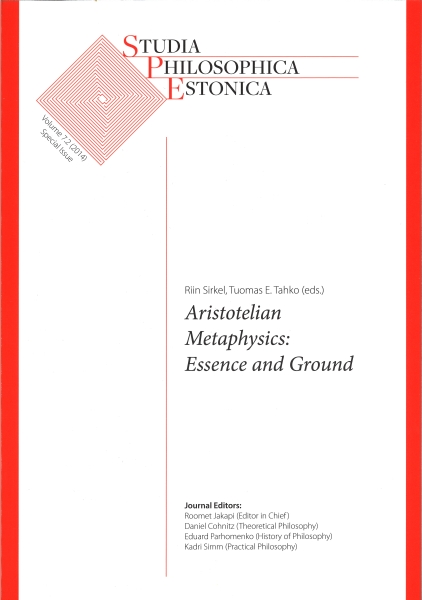Sameness, Definition, and Essence
DOI:
https://doi.org/10.12697/spe.2014.7.2.08Keywords:
essence, definition, identity, sameness, priorityAbstract
I formulate an apparent inconsistency between some claims Aristotle makes in his Metaphysics about the sameness and non-sameness relations which obtain between an object and its essence: while a (type of) object is not the same as its essence, an essence is thought as being the same as its essence. I discuss different ways in which one may propose to overcome this apparent inconsistency and show that they are problematic. My diagnosis of the problem is that all these putative solutions share the assumption that Aristotle is operating exclusively with the notion of strict numerical identity between an object and its essence, or between definiendum and definiens. I introduce the notion of sameness in nature which holds between an object and its essence, understood as the metaphysical counterpart to the relation of 'being defined as': two items are the same in nature just in case the answer to the 'what is it?' or 'what is its nature/essence?' question is common to both. I argue that the notions of sameness in nature and 'being defined as' need not (but may) entail strict identity. Further, they are compatible with, indeed require, the idea that an essence is prior to its essence-bearer, or that a definiens is prior to the relevant definiendum. I conclude that the twin notions of sameness in nature and 'being defined as' successfully defuse the apparent inconsistency formulated at the outset.
Downloads
References
Charles, D. (2011). Some remarks on substance and essence in Metaphysics Z. in K. Ierodiakonou and B. Morison (eds), Episteme etc.: Essays in Honour of Jonathan Barnes, Oxford University Press, Oxford, pp. 151-171.
Jaeger, W. (ed.) (1957). Aristotelis Metaphysica, Oxford Classical Texts, Oxford University Press, Oxford.
Lowe, E. J. (1999). Form without matter, in D. S. Oderberg (ed.), Form and Matter: Themes in Contemporary Metaphysics, Blackwell, pp. 1-21.
Lowe, E. J. (2008). Two notions of being: Entity and essence, Royal Institute of Philosophy Supplement 62: 23-48.
Lowe, E. J. (2012a). Asymmetrical dependence in individuation, in F. Correia and B. Schnieder (eds), Metaphysical Grounding: Understanding the Structure of Reality, Cambridge University Press, Cambridge, pp. 214-233.
Lowe, E. J. (2012b). A Neo-Aristotelian substance ontology: Neither relational nor constituent, in T. Tahko (ed.), Contemporary Aristotelian Metaphysics, Cambridge University Press, Cambridge, pp. 229-248.
Lowe, E. J. (2013). Neo-Aristotelian metaphysics: A brief exposition and defence, in E. Feser (ed.), Aristotle on Method and Metaphysics, Palgrave Macmillan, pp. 196-205.
Peramatzis, M. (2011). Priority in Aristotle’s Metaphysics, Oxford University Press, Oxford.
Peramatzis, M. (2014). Matter in scientific definitions in Aristotle, Oxford Handbooks Online, Oxford University Press, New York.
Peramatzis, M. (n.d.). What is a form in Aristotle’s hylomorphism. Unpublished manuscript.
Ross, W. D. (ed.) (1924). Aristotle. Metaphysics, Oxford University Press, Oxford. Translated by W. D. Ross.
Shalkowski, S. A. (2008). Essence and being, Royal Institute of Philosophy Supplement 62: 49-63.
Zylstra, J. (2014). Dependence and fundamentality, Studia Philosophica Estonica 7.2: 5-28.

